Essenes’ Myth and False Beliefs about Qumran and Flavius Josephus
by
Edouard M. Gallez
See also Fabricating the Essene Monks.
-
“Le Nouvel Observateur echoed the Revue de Qumran (winter 2006) in announcing the discovery of latrines at the site of Qumrân, latrines which lent credence to the Essene thesis. Supposedly, the sect of the Essenes had fixed rigorous rules concerning the places of toilet, with the recommended burial of excrement with a shovel, and that only to the northwest of the dwellings, about five hundred meters away. As discoverer Joe Zias explained, “the Bedouin of the desert have no such custom. So, we finally have proof of the Essene occupation of the site” ”.
Then American and French websites were quick to pass on this “news” by way of the two researchers, Joe Zias, an Israeli from the Rockefeller Museum in Jerusalem, and the other American, James Tabor.
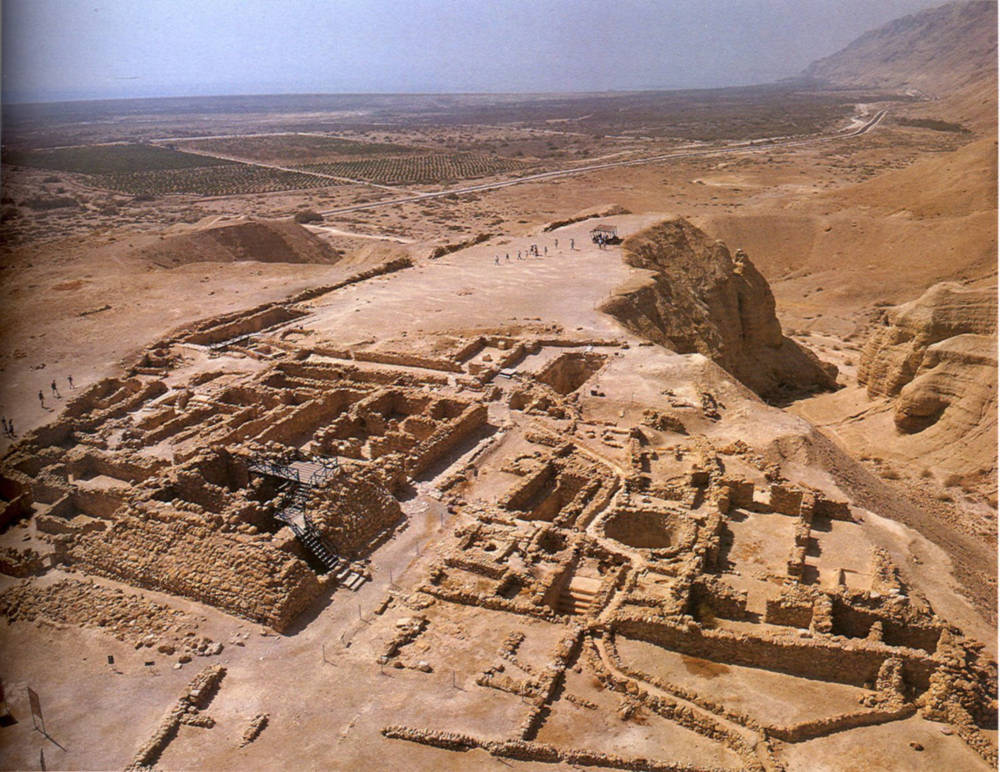
Qumran
settlement, viewed from the West, showing latrine area.
The
article by Cécile Dumas which appeared in Nouvel
Obs (“Qumran: les
esséniens trahis par leurs latrines” [“Qumran: the
Essenes Betrayed by their Latrines”]) nevertheless cautiously
mentioned that the Essene “hypothesis:”
“…was
questioned in 2005 by two Israeli researchers, Yitzhak
Magen and Yuval
Peleg. After nine years of excavation at Qumran, Magen and Peleg
had asserted that there had never been an Essene monastery on the
site of the old fortress, but only a pottery factory.”
A Quick Review Of The Essene Question
As early as October 2004, the
journal Sciences et
Avenir announced that
the ten excavation campaigns carried out by Magen and Peleg were
“…the
most important since the time of Roland
de Vaux:”
“The
discovery of coins, pottery and especially jewelry invalidates the
thesis, according to which this site housed the famous sect of the
Essenes, who lived in poverty for spiritual reasons and who would
have been the authors of the Dead Sea Scrolls.”
These challenges, in fact, were not new. For years the archaeological material had spoken, although it was partially still under investigation because of its abundance. In 1992, the colloquium organized by the New York Academy of Sciences (and published in 1994) should have put an end to the assumptions that absolutely want to establish a link between the site and the texts found nearby (or several kilometers away, in the 10 or 11 others Dead Sea Caves). The reliable data, in fact, proceeded in a different direction entirely:
The “Essenes of Qumran” hypothesis assumes that the inhabitants of the site were “monks” and that they wrote the texts found in twelve caves near and far. They therefore had to devote time to writing. It was thus imagined that they had a room devoted solely to this single activity. For the rest, they lived very poorly, one on top of the other (for lack of space), until they disappeared in the year 68 AD, during the first “Jewish War.”
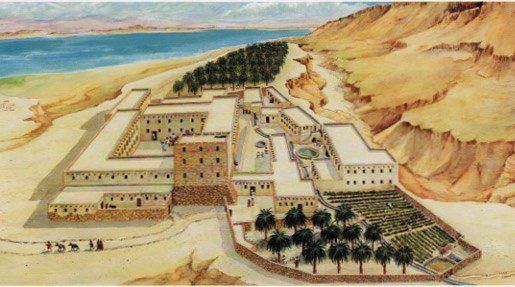
Qumran:
A reconstruction.
However, in 1992, archaeologist Pauline Donceel-Voûte demonstrated that what we took to be the remains of writing tables were nothing other than pieces of fixed dining tables or benches (also fixed and arranged along the walls); and when correctly put back together, the remains corresponded perfectly to the usual version of a dining room in the East and in other parts of the Roman Empire, particularly being on the floor, where one could enjoy the freshness of the evening.
The arguments for the Essenes, advanced by archaeologists, are based on the presence of two inkwells and on the (medieval) patern of rooms totally devoted to the copying of manuscripts. Thus, the room with the two inkwells was called the scriptorium, as per the monks of the Middle Ages (that is to say, a thousand years later).
In fact, the only two inkwells found there (locus 30) did not even belong to the level of the remains of the first floor (where the Essene scriptorium is believed to have existed), but rather were found on the ground floor. It should be added that this supposition is really unnecessary: serious historians of antiquity know that, unlike Rome, where there were copying companies, copyists in the East were itinerant scribes who worked on the tablets they themselves carried. There is not the slightest reason to imagine a brotherhood of copyists, just because we have found a lot of manuscripts. In short, the scriptorium of the Essene monks is not history.
In fact, the site was always an economic one, linked to the harvest of balsam, a wild shrub that only grew in this region (not at all a desert at the time) and whose scented essence was of enormous value. This essence was stabilized using extracts from bitumen which was available just East of the Dead Sea. Several geographers and historians of antiquity speak of it. We also know that Queen Cleopatra of Egypt, a great consumer of perfumes, obtained possession of this region from Antony (she would hardly enjoy it, however, given the victory of Julius Caesar).
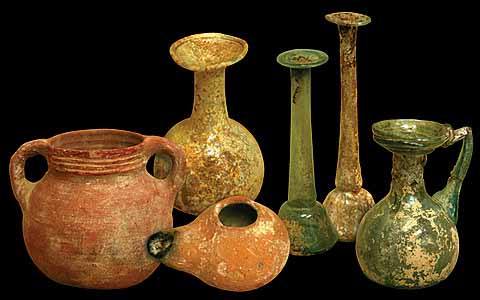
Glass
vials and jar; ceramic lamp and jug. _
Among the archaeological materials found on the site of Qumrân are also pottery and glass. Remnants of production from both indicate on-site manufacturing; this manufacturing was not year-round but only during the stay of specialized, itinerant craftsmen. The manufacturing of glass was very costly. Such a cost was justified given the production of vials intended to contain the various perfumes – which were used less for cosmetics than for worship and burials.
Such economic profitability is enough to explain the probable presence of soldiers, on-site, or in the surroundings – for such wealth was subject to robbery[1]. The pottery produced on the spot was mainly for the use of the inhabitants (the rich). “Cave 4,” located under the promontory, may have served as a warehouse, well protected from hot weather; this would explain the (probable) presence of shelves.
A complex set of open-air pipes brought water from heavy rains, or from the mountains, into the cisterns. But it only rained in certain months of the year; hence the large number of these tanks. Slightly dug into the ground rather than underground (which would have required a lot of work), they had to be covered to limit evaporation. Steps made it possible to descend to draw water, as the level fell. These accumulated amounts of water were nevertheless sufficient for pottery to be made at certain times of the year. There is no evidence to suggest that a single one of these cisterns ever served as a mikveh, that is, a place for Judaic ritual ablutions._
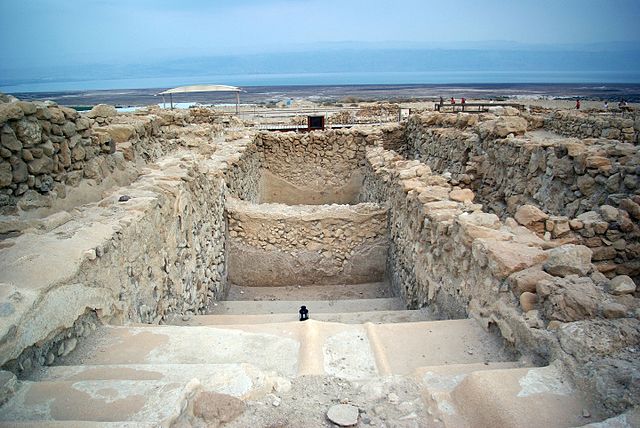
Stepped
cistern.
Numerous lamps (which by nature are quite characteristic of an era and allow it to be dated to within 25 years) have been found among the archaeological material. The date of these lamps extends into the 2nd century AD, which is not surprising, for as long as the balsam shrubs existed, such places were economically viable, except during 68 to 70 AD, because of the “Jewish War.” Activities then resumed until 135 AD (the Second “Jewish War”), or perhaps even beyond. The idea that the site was abandoned in 68 (by the “Essene monks”) is also not history.
The cemetery adjacent must have been inaugurated after the site was abandoned (that is to say, not before 135 AD at the earliest), because its proximity to the buildings would have made their inhabitants impure. Much of our knowledge of graves dates back to the few excavations carried out in the 1950s (by de Vaux), not that there haven’t been any since – but these new excavations were carried out in an illegal context, and their results cannot therefore be officially published. The old idea that the majority of the people buried there are men remains open to question until it is confirmed by the facts (which in themselves can be explained in many ways). Very similar burial sites have been unearthed in the surrounding areas. The “cemetery of Qumran” therefore does not offer the specificity that has been invented for it, by making it the cemetery of “Essene monks.”
Sometime after 135 AD, this cemetery was used again (probably at several times). We can assume that the ruins offered an ideal place to camp for the many visitors who followed one after the other. This would explain the presence in these places of very late coins (which date up to the 6th century AD).
It is important to keep in mind all this demonstrated archaeological data, before coming to grips with the interpretative hypotheses which so want to associate the site with the manuscripts of the caves, the cemetery and certain passages (more than doubtful) of the historian of the Jewish War, namely, Flavius Josephus.
The Zias-Tabor Article and the fake passages in the writings of Flavius Josephus concerning the Essenes
In addition to the various
claims in the Zias-Tabor article, one notices that the burying of
excrement is not the characteristic of a small Jewish sect. In the
Bible, we read in the book of Deuteronomy:
“You
shall also have a place allocated outside the camp, so that you may
go out there to relieve yourself, 13 and you shall have a [h]spade
among your tools, and it shall be when you sit down outside, you
shall dig with it and shall turn and cover up your excrement…
so He must not see anything indecent among you or He will turn away
from you” (Deut.
23:13-14).
This prescription is therefore of general application to all the sons of Israel, with modifications (which have not been lacking). It is this prescription which evokes Book II of the Jewish War, where we read moreover that the “Essenes” do not go to the toilet on the Sabbath day. According to James Tabor, this requirement would correspond to the situation in Qumran, where the latrines are located further than the number of steps allowed on such a day. This is nothing more than the need to attribute the Messianist current, which produced many Dead Sea texts, to rabbinical rules which have nothing whatsoever to do with this Messianist current. But things get worse.
The entire passage concerning the “Essenes” exists in the Philosophoumena, and the comparison of the two texts clearly shows the mutilations that the passage underwent in transmission. In the Greek version of Josephus, everything, in fact, indicates that this constitutes an interpolation, carried out in the 3rd century, on the basis of the record of the Philosophoumena, by a pagan author linked to imperial power, who is very mocking and rather anti-Semitic. This passage, moreover, is absent from the manuscripts of the Latin Hegesippus, as well as those of the Hebrew Josippon. In fact, the very name “Essenes” is unknown there. Regarding this “name”, it is important to remember that it is that of Greek priests – those at the temple of Artemis in Ephesus, which denotes a certain sort of humor; or, at worst, a sarcastic touch [2]. And just after the mention of what the “Essenes” do not do on Shabbat, we read that on other days they do it “wrapped in their cloak so as not to offend the sight of God.” If that is not mockery, what is it? Such derision arises throughout the reading of the passage.
The non-critical use of Josephus and the connection with the situation of latrines outside the biblical context is just not admissible. But that is not all.
Details Presented As “Evidence”
In the Dead Sea Scroll, called
the Temple
Scroll, we read
this:
“You
will make a certain place for them outside the city. This is where
they will go, outside northwest of town. You will make aids there,
frames with pits in the middle into which the excrement will descend,
and it will not be visible to anyone being away from the city of
three-mile cubits [± 500 m]” (11QT
46,13).
Let us suppose that there are
indeed correspondences with the latrines discovered by Zias –
but are they “proofs,” or simply a series of partial and
fortuitous connections? On site, there is no trace of a deep pit or
aedicule. The situation in the Northwest is not significant either –
for latrines certainly could not have been eastwards, out in the
emptiness. As for the approximate distance, it does not correspond to
what this other manuscript indicates:
“There
will be a space of about two thousand cubits [± 350 m] between
their camp and the location, and nothing shameful and ugly will be
visible around their entire camp” (1QM
7,7 ; parall. 4Q491 frag 1 3,7).
Now, as we have seen, Deuteronomy itself prescribes a distance. There is therefore nothing in particular there. In addition, equally probable traces of other latrines have been discovered within the site of Qumran itself. What then remains in favor of the argument?
A comparison – yet one more – is still made with the deceased in the cemetery, who are supposedly overwhelmingly young men and buried there before 68 AD(!). Joe Zias wonders why they were young (which remains to be seen) – and he assumes that is because they got sick. And why were these “Essenes of Qumran” (according to the Essene hypothesis) sick? Because of the latrines and the obligation of ritual baths and purifications! Because everyone walked on contaminated soil, while complying with the laws of nature; and the water in the basins could not be replenished before the rainy season. So, after about nine months), the water was quickly polluted. The “Essenes” therefore got sick.
Of course, when the water is
polluted, it can surely be noticed with the naked eye, sooner or
later. However, for more than a hundred years, the supposed
inhabitants of the place continued to poison themselves in this way
without questioning anything, because, explains Tabor, their poor
state of health
“…must
have been such as to nourish Essene religious enthusiasm. They must
have seen their infirmities as a punishment from God, or as a lack of
purity, and therefore they tried even more to purify themselves [with
baths].”
Were the “Essenes of Qumran” so stupid? To this web of hypotheses, let us add this one – that the “Essene monks” actually preferred to recruit simple-minded people. The proof? Well, is there not the link – yet one more – to the activity of copying (sometimes several copies), which is attributed to them? They copied because very few of them were able to create an original work. Moreover, if certain manuscripts present work of different hands, that is because, being sick and tiring quickly, the copyists were replaced. These explanations constitute obvious “proofs.” Who would dare doubt?
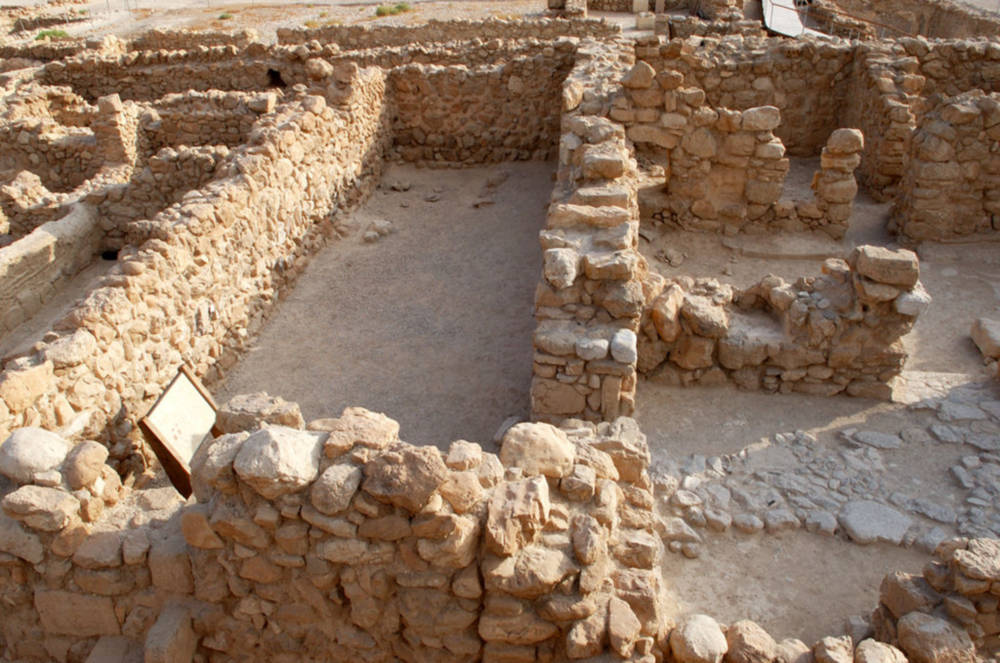
Qumran:
supposed “scriptorium.”
A belief dear in some circles
Enough. Time to put an end to this fantasy. “Essene monks” are the fabrication of hypotheses that are groundless (and often improbable). They are a construction which, alas, became the tree that hid the forest for too long, the forest of a vast Messianist current that existed and did not disappear in the year 68 AD. Quite the contrary. A question arises here: why such relentlessness in trying to demonstrate the idea of “Essene monks?”
Too often there is a gray area between the realm of scientific research and that of beliefs. Since Voltaire decreed that Jesus had gone to be trained among the “Essenes” (as he imagined them from the doctored texts of Josephus), the sect of the same name has become a belief dear in some circles. Is it a coincidence that, among 20th century scholars, those who spread this idea the most were former priests? Of course, no one takes Voltaire’s assertions seriously. However, the “Essenes” remain attractive as idea of the existence of an important Jewish current of which the New Testament would not speak and which, for its part, ignores everything about the beginnings of Christianity. And, thus, does not all this cast doubt on the veracity of the Christian witness?
Nevertheless, the heyday of the “Essene” fiction is numbered. Sooner or later, archaeology will prevail over exegesis, where presuppositions have always played a major role.
_____________
[1]
DONCEEL-VOÛTE Pauline & Robert, The
Archeology of Khirbet Qumran,
in WISE Michael O. & Alii, Methods
of Investigation of the Dead Sea Scrolls and the Khirbet Qumran
Site : present realities and future prospects
[Annals
of the New York Academy of Sciences,
vol.722], 1994, p.26-27.36. See also Dossiers
d’Archéologie,
Dijon , 1999 , 240 , p. 90-123.
[2] See Le messie et son prophète, 1.1.1.2 and footnote 47. For an analysis of the entire passage written by Fl. Jos, see Idem, Volume I, p.72-91.